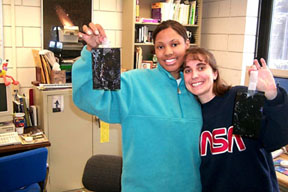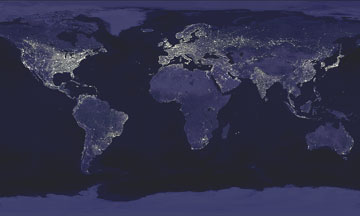Credits for Resources and Images within Windows to the Universe
One of the objectives of Windows to the Universe is to bring together information and resources from scientific, artistic, historical, and cultural sources. We are attempting to build a site that is rich both in information content as well as filled with a wealth of relevant images. We have endeavoured to obtain copyright clearance and all relevant permissions for the use of the images included here which are not in the public domain. We offer our sincere apologies to anyone whom we may have unknowingly left out in this search for clearance. Please use our comments form to inform us of any additional clearances that may be needed. We would like to thank the many individuals and institutions who have given us permission to use their images, movies, and data. As resources continue to be added to Windows, this list of credits will continue to grow. Continue exploring Windows to the Universe.
Scientific Resources
Unless otherwise noted, images available within Windows to the Universe are either developed by the Windows team, or are in the public domain.
Our thanks to NASA, NASA/JPL, and numerous crews on NASA space missions for the many hundreds of fabulous images and data sets which enrich our pages.
Our thanks to the John F. Kennedy Library for providing a tape of President Kennedy's "Man on the Moon" speech.
Rick Kohrs, GOES6 satellite image of Earth, September 21, 1986.
- NASA/Aris Multimedia Entertainment, Inc. 1994:
- Earth's Western Hemisphere
- Cyclonic Storm
- Tropical Storm
- Edwin Aldrin
- Earthrise
- Lunar Rover
- Volcanoes on Adonara Island
- Mauna Loa Volcano
- Mt. Shasta volcano
- Sun reflecting in the Ocean
- Sargasso Sea
- Emirates River
- Colorado River
- Arabian Gulf of Oman
- Grand Canyon
- Gulf of Mexico
- Hawaiian Islands
- Sahara Desert
- San Andreas Fault
- Sinai Desert
- Volcano on Venus
- Clouds on Venus
- Hubble Space Telescope
- HST and Earth
- HST panels opening
- HST on the shuttle arm
- Discovery launch
- Columbia launch
- Columbia lift-off
- Space shuttle's front view touchdown
- Atlantis take-off
- Atlantis touchdown
- Front-view image of the space shuttle Atlantis
- Artist's conception of a space shuttle over the Earth with the Moon in the background
- Eclipses
- Crescent of Uranus
- Saturn's rings (3 images)
- Cyclonic Storm
USGS, mosaic image of US based on NOAA-8 and NOAA-9 data.
USGS, mosaic images of Mars.
- LPI/NASA:
- Earth's limb
- Twin impact craters at Clearwater East and West, Quebec
- Great Barrier Reef
- Twin impact craters at Clearwater East and West, Quebec
Ronald Holle, Altocumulus clouds, University of Illinois cloud catalog.
NOAA Storm Spotters Guide/University of Illinois cloud catalog, Tornado spawning from a cloud.
University of Illinois Cloud Catalog, Hurricane over Mississippi and Louisiana
D. Roddy/LPI, Photo of Barringer Meteor Crater, Arizona
S. Rowland/LPI, Lava Channels at Pu'u O'o Volcano, Hawaii
V. L. Sharpton/LPI, Photo of Wolfe Creek Crater, Australia
W. U. Reimold/LPI, Photo of Roter Kamm Crater, South West Africa
Volcano World, Satellite image of Mount St. Helens
Environmental Research Institute of Michigan (ERIM), satellite image of the Great Lakes
National Air and Space Museum, photos of Sputnik 1 and Explorer 1 J. O. Burns, E. J. Schreier, E. D. Feigelson/NRAO/AUI, Centaurus A (NGC 5128).
S. Akasofu, Aurora over Fairbanks, Alaska.
G. Wynn-Williams, Orion, Copyright 1992 by [Press Syndicate of the University of Cambridge].
Supernova shock wave, the solar nebula, building the planets, the nebula disperses and the solar system today. Reprinted, by permission, from Horus Editions Ltd. Illustrated by Sebastian Quigley/Linden Artists Ltd.
- SPL/Photo Researchers:
- Portrait of Christiaan Huygens
- Portrait of Nicolaus Copernicus
- Virginio Schiaparelli
- Portrait of Nicolaus Copernicus
Dr. Jeremy Burgess/Photo Researchers, Evening primrose in day light.
Dr. Jeremy Burgess/Photo Researchers, Evening primrose in ultraviolet.
Williams and Metcalf/Photo Researchers, Thermogram of a kettle.
- Daedalus Enterprises, Inc., Ann Arbor, MI - Multispectral Images of:
- Mt. Oyama, Japan
- Forest Fires at 3 wavelengths
- Heat loss from houses
- Heat loss from power plants
- Infrared/Visible images of people in different dress
- Forest Fires at 3 wavelengths
David Kozyra, Acro Photographics, Ann Arbor, MI
Professor S. Akasofu. Copyright 1989 by Scientific American, Aurora views
NASA/Smithsonian Astrophysical Observatory, Xray image of supermassive black hole
NRAO/AUI, visible image of supermassive black hole
National Optical Astronomy Observatories, radio image of supermassive black hole
Harvard College Observatory, Orion constellation
Jet Propulsion Laboratory/California Institute of Technology, dust cloud
National Radio Astronomy Observatory/AUI, molecular cloud
- Perfect Vision Graphics:
- oceans and seas
- tiger
- duck
- tiger
Chris Vincent and Eric Bucsela, Tornado
EarthWatch Communications, Inc, Hurricane images
Atmospheric and Environmental Research, Inc, Hurricane Luis and Felix
UCAR UNIDATA Project and the University of Hawaii at Manoa, Hurricane Hugo
Steve Albers, thunder and lightning, rainbow
Jyrki Manninen, aurora
- Anglo-Australian Observatory:
- Trifid Nebula in Sagitarius
- Cone Nebula
- Helix Nebula
- M 16 Nebula
- Horsehead Nebula
- Tarantula Nebula
- Eta Carinae and the Keyhole Nebula
- Startrails
- A young open cluster
- Wolf-Rayet star
- The Jewel Box cluster
- The stars that excite the Trifid Nebula
- Barred Sprial Galaxy
- Seyfert Galaxy
- a spiral galaxy
- Centaurus A
- Cone Nebula
Michael Meyer,infrared cluster associated with NGC2024 nebula
WIYN Consortium, Inc., star image in Andromeda
Dr. Christopher Burrows, ESA/STScI and NASA,three rings of glowing gas
C.R. O'Dell/Rice University and NASA, a very young star
Dr. John Hutchings,Dominion Astrophysical Observatory, NASA, Quasar's host galaxies
- 1993 Smithsonian Institution:
- Freedom 7
- Model of the Voyager spacecraft
- Spacecraft in the late 19th century
- Interior of a Lunar Module
- Lunar Roving Vehicle
- Surveyor spacecraft
- Skylab 1
- Apollo Command and Service Module docked with the Soviet Soyuz spacecraft
- Tracking and Data Relay Satellite Michael Malin, Malin Space Science Systems, Inc.,flight system design for the proposed Venus Geophysical Network Pathfinder mission.
- National Air and Space Museum:
- Surveyor 3 television camera
- Saturn F-1 engine for the Saturn V rocket
- Lunar orbiter
- Saturn F-1 engine for the Saturn V rocket
High Altitude Observatory, National Center for Atmospheric Research (NCAR), Boulder, Colorado, USA. NCAR is sponsored by the National Science Foundation, white-light coronameter image
Paul Charboneau and Alice Lecinski of High Altitude Observatory
Serge Koutchmy of Institut d'Astrophysique, Paris, CNRS
Lockheed Palo Alto Research Laboratory, X-ray image of the sun taken with the Soft X-Ray Telescope
Jay Keller, image of an eclipse taken in Mexico
- Sacramento Peak Observatory:
- Sun's core
- solar flare
- corona
- solar flare
Northern Lights Planetarium, eclipse of the sun
Northern Lights Planetarium, Northern Lights
Franck Pettersen, different phases in a northern lights outburst
Hal Weaver (Applied Research Corp.),HST Comet Hyakutake Observing Team and NASA, image of Comet Hyakatuke
Courtesy of Tom Herbst, Max-Planck-Institut fuer Astronomie, Heidelberg, Doug Hamilton, Max-Planck-Institut fuer Kernphysik, Heidelberg, Hermann Boehnhardt, Universitaets-Sternewarte, Muenchen, and Jose Luis Ortiz Moreno, Instituto de Astrofisica de Andal ucia, Granada, Sequence shows the A impact of July 16, 1994
Mark Marley and Nancy Chanover, Department of Astronomy, New Mexico State University, Near-infrared image of the G and D impacts on Jupiter
Hubble Space Telescope Jupiter Imaging Team, color image of the fragment G impact site
Courtesy of H.A. Weaver, T.E. Smith (Space Telescope Science Institute) and J.T. Trauger, R.W. Evans (Jet Propulsion Laboratory), and NASA, Illustration of Comet P/Shoemaker-Levy 9 and Jupiter
NASA/STScI and B. Zellner, Georgia Souther University, Montage of 24 images of the asteroid Vesta
Reta Beebe (New Mexico State University), D. Gilmore, L. Bergeron (STScI), and NASA, Storm on Saturn
Ken Hodges, artist rendition of the Galileo Probe parachuting into Jupiter's atmosphere
David Seal,JPL, artist rendition of the Cassini spacecraft
- Calvin J. Hamilton and NASA:
- Crescents of Neptune and its moon Triton
- Small Dark Spot
- Cirrus-type clouds in Neptune
- Saturn taken from Voyager 1
- Tharsis Montes volcano region on Mars
- Local dust storm on Mars
- Mary A. Dale-Bannister, Washington University in St. Louis, Viking Lander 2 site on Mars
- Small Dark Spot
NASA/STScI and Dr. Heidi B. Hammel, Disappearance of the Great Dark Spot
NASA/STScI and Dr. Heidi B. Hammel, Three images of Neptune
- Model of the Voyager spacecraft
Artistic and Cultural Resources
"The Infant Bacchus Entrusted to the Nymphs of Nysa; The Death of Echo and Narcissus" by Nicholos Poussin (1657). Courtesy of the Fogg Art Museum, Harvard University Art Museums, Gift of Mrs. Samuel Sachs in memory of Mr. Samuel Sachs. To be reproduced only by permission of the Harvard University Art Museums.
"Venus and Mars" by Sandro Botticelli, Reproduced by courtesy of the Trustees, The National Gallery, London.
"The Birth of Venus", Nicolas Poussin (1638-1640), Philadelphia Museum of Art, George W. Elkins Collection.
"Neptune Calming the Tempest" by Peter Paul Rubens (1635). Courtesy of the Fogg Art Museum, Harvard University Art Museums, Alpheus Hyatt Fund. To be reproduced only by permission of the Harvard University Art Museums.











